
Chase the Fall Colors on Minnesota's North Shore
Chase the Fall Colors on Minnesota's North Shore
By Brian Fanelli
With charming small towns, magnificent foliage and colorful art tours, fall on Minnesota's North Shore is a truly magical time that all but demands an annual visit.

Warm coffee by the campfire / Micah Kvidt
You wake up at dawn, when the morning’s sunlight slowly begins to fill your tent. As you fire up the camp stove for a much-needed cup of coffee, you watch the sun emerge over Lake Superior to begin its daily parabola. Its light paints the majestic Sawtooth Mountains that define much of the North Shore’s rolling topography in a deep shade of orange, like a sepia-toned photograph. You hear family members rustling in their tents, but for now it’s just you and the shore.
Steam rises from your coffee. The hot enamel mug warms your hands. Light spills over the horizon to bounce off the glassy waters of Lake Superior and reflect the sky into a seemingly infinite expanse, perfectly still and impossibly perfect.
This is what fall on Minnesota's North Shore is all about.

Looking toward downtown Duluth from Canal Park / Ty Miller
Duluth, Gateway to the North Shore
In honor of the city’s maritime past and present, anchor your trek up the North Shore by spending your first night of vacation in Duluth. As northeast Minnesota’s largest city and the unofficial gateway to the North Shore, Duluth is an obvious first stop on your adventure up the shoreline. Still the largest and busiest Great Lakes port by far, modern-day Duluth strikes a careful balance between its industrial roots and forward-thinking, current focus on tourism.
Like many industrial American cities, Duluth only recently rebounded from the steel collapse that crippled Rust Belt regions in the 1970s and ’80s. Few destinations better embody the city’s renaissance than Glensheen. Completed in 1908, Glensheen began as the opulent home of Clara and Chester Congdon, and stayed in their family until its conversion to a house museum in 1979, the same year that Duluth’s last remaining steel mill closed for good. Despite a successful first two years of operation, in 1981 the museum dovetailed the city in a decades-long decline before successfully reemerging as what is now a must-visit destination.
Glensheen’s revitalization began in 2013, one year before Outside Magazine named Duluth the best town in America. Like the rest of Duluth, Glensheen’s revival is deeply indebted to its past but never looks entirely backward. Visitors flock to the museum both to bask in its extravagant, turn-of-the-century architecture and grounds, but also for its new community events and endlessly inventive tours. Today, Glensheen stands as a testament to both old and new Duluth: steeped in history, eyes on the future.
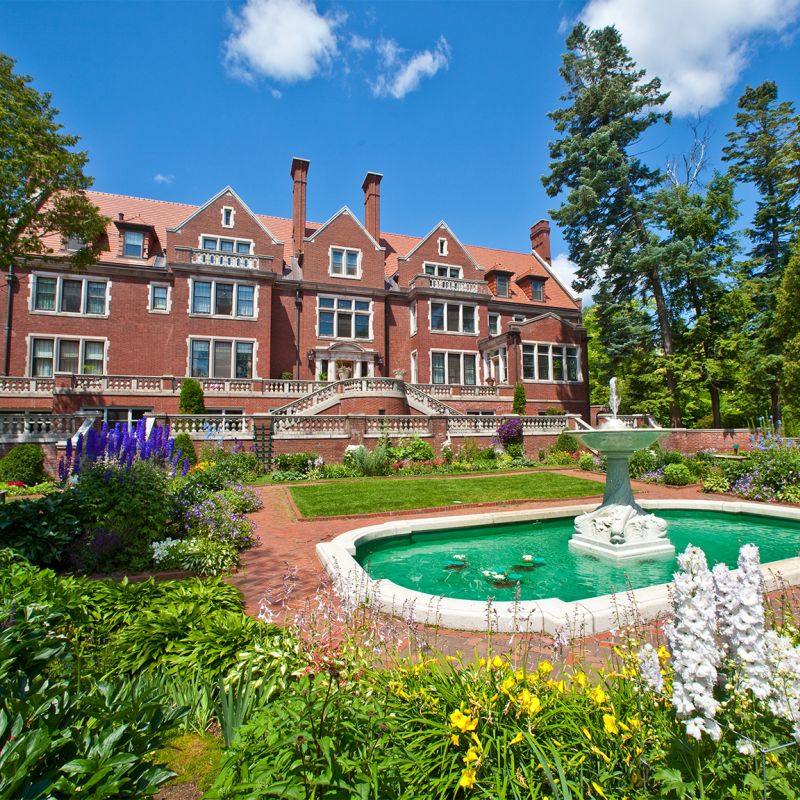
Glensheen Mansion in summer, Duluth / Dennis O'Hara
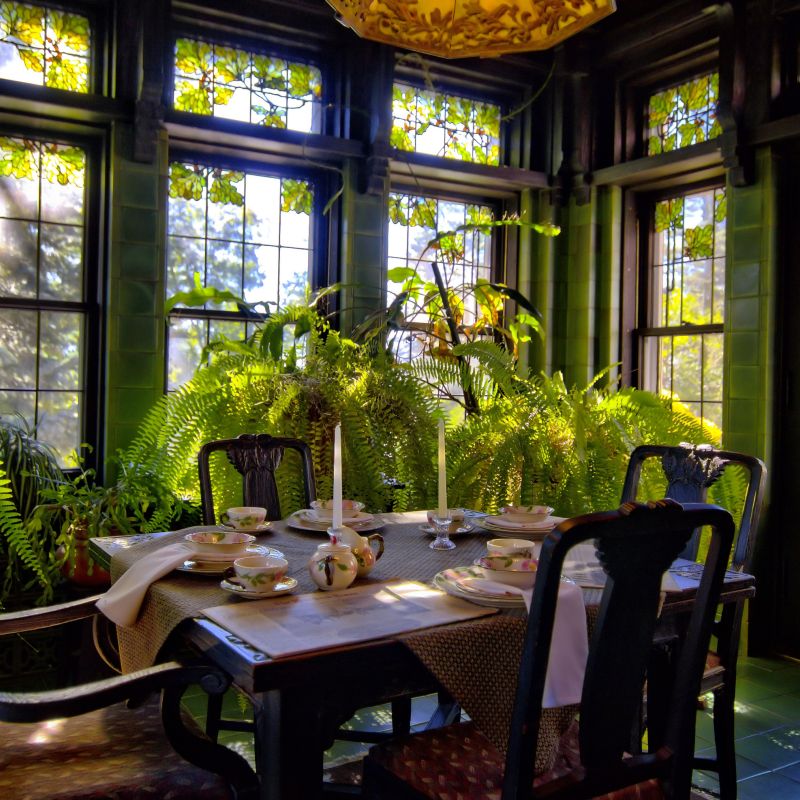
The breakfast room at Glensheen in Duluth / Greg Riekens
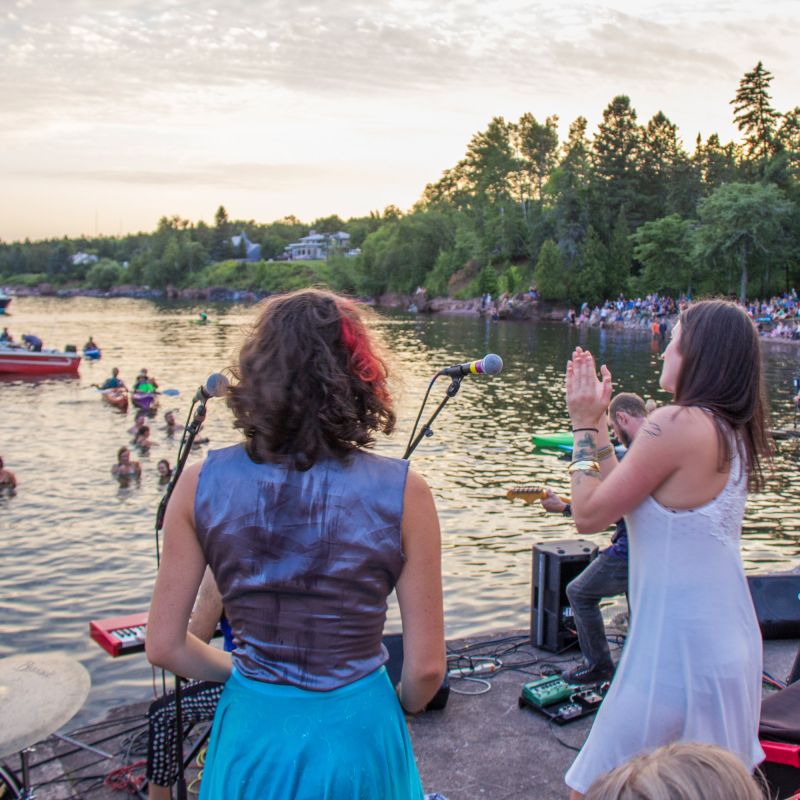
Concerts on the Pier at Glensheen, Duluth
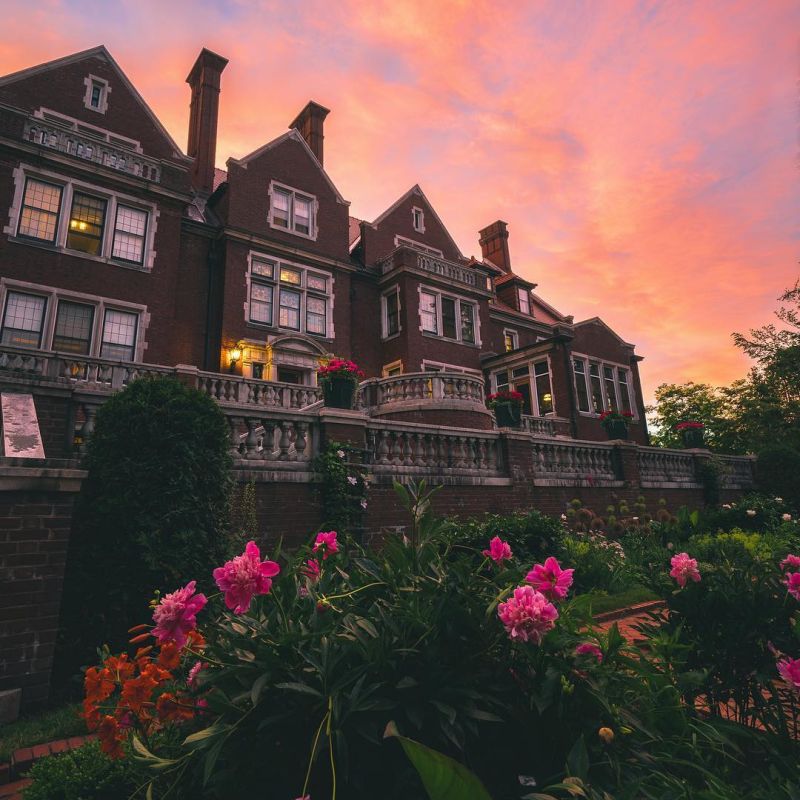
Glensheen Estate in Duluth at sunset / @georgeduluth
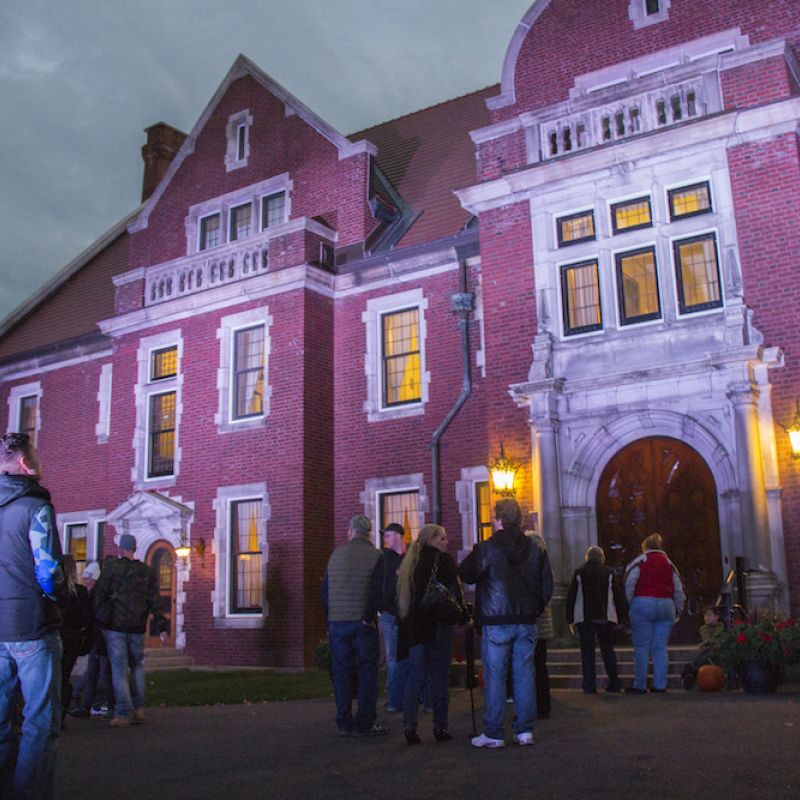
Duluth's Glensheen Mansion at night
The popular Canal Park adjacent to the lake is abuzz with restaurants, breweries and boutique storefronts, but reminders of the city’s origins as a major shipping hub are never far from sight. The skeletal, steel lattice of the iconic Aerial Lift Bridge is Duluth’s most recognizable landmark, and remains a functional and vital part of the city’s present-day shipping economy. Watch in awe as the bridge rises 138 feet in less than a minute to make room for large, seagoing vessels as they come through the canal.

Fall color bursts along the St. Louis River / William Wensel
Where Fall Happens Twice
For many visitors, nothing beats chasing the fall colors on one of the shore's three scenic byways—the North Shore, Superior National Forest and Gunflint Trail. But like all things autumn, timing is everything. Fortunately, the North Shore is a uniquely easy destination for viewing the fall colors because, unlike anywhere else in Minnesota, fall comes to northeast Minnesota twice.
The North Shore has two distinct seasons of fall colors: one for the inland maple trees found on the Sawtooth Mountains’ high ridges, and a second wave of aspen and birch trees directly along the shoreline. The highland fall colors peak begins in mid-September and can continue through early October, while the later shoreline peak begins in late September and runs through mid-October.

Sawmill Dome on the Superior Hiking Trail near Tettegouche State Park / Alyssa Hei
Early season foliage hounds can chase the colors on the inland Superior National Forest and Gunflint Trail byways. Pick up the Superior National Forest Scenic Byway in Silver Bay, a 55-mile jaunt up the shoreline from Duluth, or continue heading north another 55 miles to Grand Marais to reach the Gunflint Trail. Both begin on the North Shore before heading inland, providing a nice contrast between the two fall seasons' colors.
Proximity to the cool air rushing off Lake Superior means peak fall colors come to the North Shore Scenic Byway two weeks after the inland peak has begun—great news for late-season travelers. This sublime, shoreline-hugging scenic byway is one of the most scenic drives in America.
During this spectacular, 175-mile trip up the shore, be sure to explore at least one of the eight Minnesota State Parks found along the route, grab a photo at one of the many waterfalls, and sit down for an authentic, homemade meal at a charming small-town restaurant, many of which specialize in locally sourced fare.

Flying high on the Summit Express gondola at Lutsen Mountains / Lisa Meyers McClintick
For a bird’s-eye view of the shore, take a ride on the Summit Express Gondola at Lutsen Mountains. Gliding from the shore to the Sawtooth mountaintops, the ride offers unparalleled views of the North Shore’s most dramatic fall scenery. Step out of your gondola at the summit for a meal with a view at the Summit Chalet, and enjoy a post-meal stroll on the scenic mountaintop hiking trails as the sun disappears out of view.

Fishing on the Baptism River in Tettegouche State Park
Outdoor Adventures Await
Beyond simply chasing the fall colors, fall is the perfect time for “up north” outdoor adventures. Thanks to its brisk weather, dwindling mosquito population and beautiful backdrop of changing leaves, fall is one of the best times to get outdoors on the North Shore.
Breathtaking landscapes and well-maintained backcountry campsites entice hikers to explore the scenic northern wilderness.
Beginning in September, many of the rivers and streams of northeast Minnesota come alive with freshly hatched migratory species, making it a prime season for fly fishers. The North Shore's tumultuous streams are home to rainbow, brook and brown trout, plus Atlantic, Chinook, coho and pink salmon. Because trout and salmon congregate mostly by river mouths along the shore, fly fishing is the preferred method of catching them, but you may find them while angling in the big lake, as well.
The season's dropping water temperatures in Lake Superior cause many larger fish to leave their summer homes in the lake's deeper areas to feed and get ready for winter along the shoreline, so it's lunkers as far as the eye can see for anglers who venture onto the big lake in fall. Hiring a fishing guide can help with the ins and outs particular to fall fishing, and many resorts and bait shops can recommend good local guides.

Hiking in Section 13 of the Superior Hiking Trail / Alyssa Hei
Fall hiking is another popular activity along the shore, especially on the 310-mile Superior Hiking Trail that runs from Jay Cooke State Park to the Canadian border at Grand Portage. The region's breathtaking landscapes and well-maintained backcountry campsites entice hikers to explore the scenic northern wilderness for hours, days and even weeks at a time.
The simplest way to sample the trail is to pick a short loop section, like the easy but stunning Oberg Mountain Loop near Lutsen, or the Gooseberry loop at Gooseberry Falls State Park. For a more ambitious day hike (or longer), a shuttle service runs Friday-Sunday through mid-October. Reservations are recommended in order to guarantee seating. The Superior Hiking Trail Association also leads free, guided fall color hikes on weekends in late September and early October.
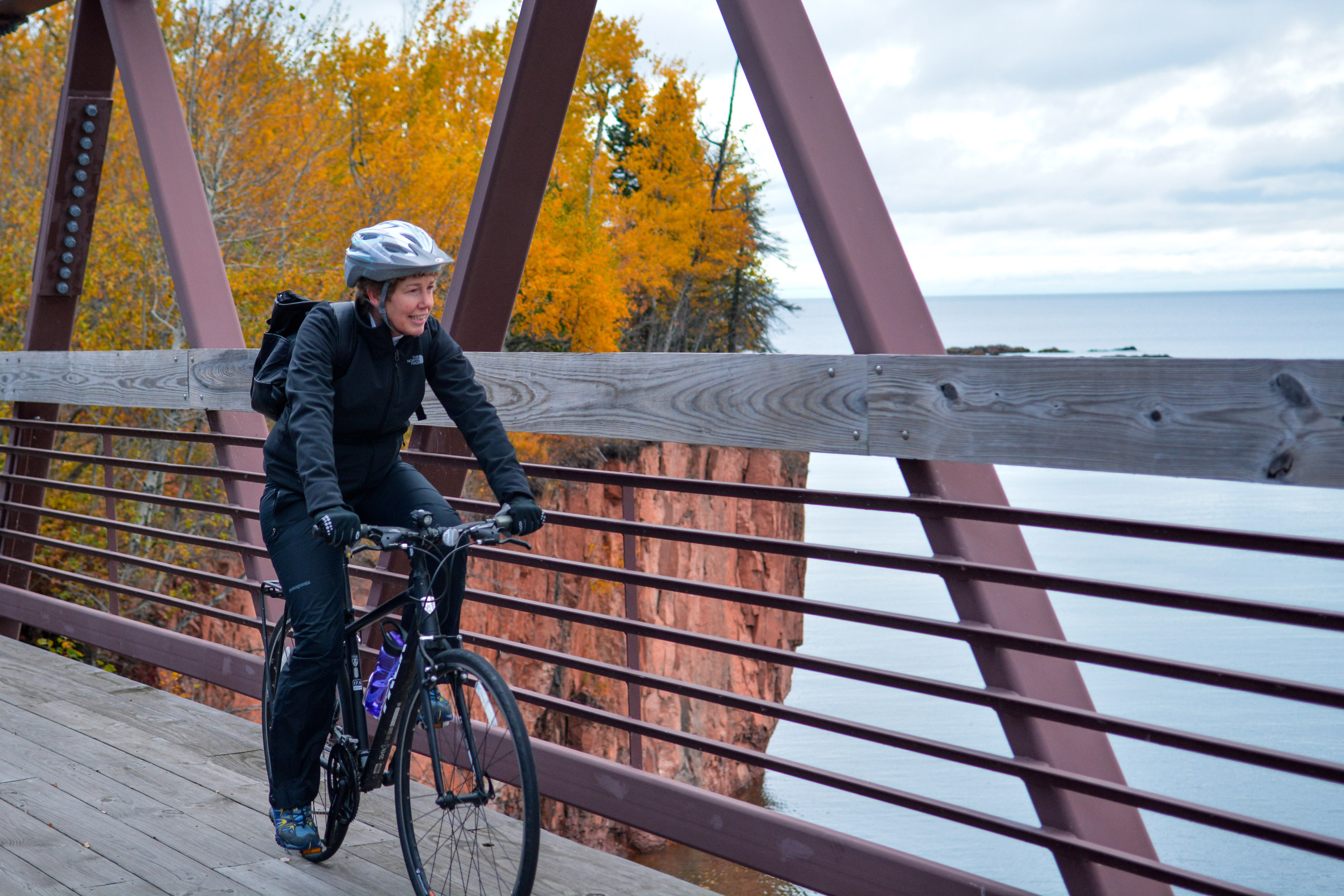
Blue water, red cliffs and yellow leaves welcome bicyclists on the lakeside Gitchi-Gami State Trail
For road bicyclists, the Gitchi-Gami State Trail includes several paved segments along the North Shore, the longest of which is a 17-mile stretch from Gooseberry Falls State Park to Silver Bay. Head out for a loop on the trail's Gooseberry section for a stunningly beautiful ride featuring multiple waterfalls, dense coniferous forest, leaves of every color imaginable, and the famous Split Rock Lighthouse overlooking the lake's rocky shoreline.
The shore is also famous for its award-winning golf courses, although the scenic surroundings do tend to make concentration a little harder than average. The visually stunning, 27-hole Superior National Golf Course in Lutsen — previously named the No. 1 public golf course in Minnesota by Golf Digest — is a real hole-in-one. Further north by Grand Marais, play a quick nine at Gunflint Hills Golf Course, a par 36 that’s as beautiful as it is challenging.


